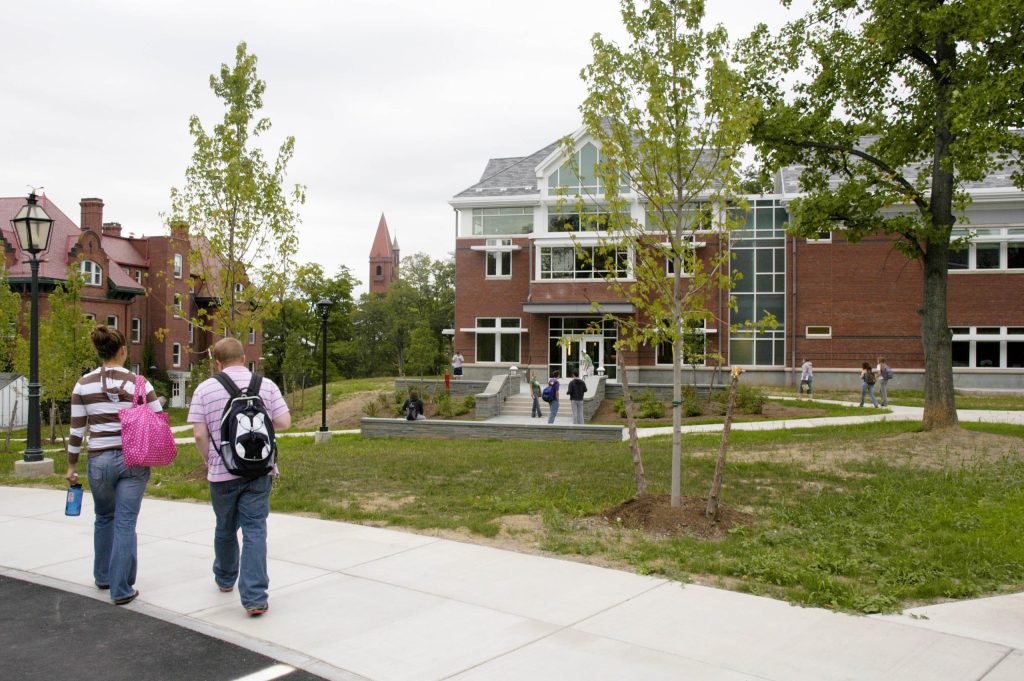The students were the last to know.
On April 29 – just a week before finals – Wells College announced that it would close. The last-minute decision by the 156-year-old liberal arts college in upstate New York sent students rushing to find new colleges for the fall. And it threw newly accepted students, who had already put down deposits, into a frantic scramble to see if the colleges they had turned down would take them back. Faculty members, having missed the academic hiring cycle, were left facing unemployment.
But there is mounting evidence that Wells administrators knew for months that the college would close, even as they made public assurances that all was well.
Wells quietly made student transfer arrangements with another college last fall, according to Wells’ accreditor. And Wells agreed earlier this year to convert the land-use zoning for the campus from institutional to mixed use, which would allow the buildings and land to be used, and sold, for non-educational purposes.
Wells joins a parade of colleges that have been closing this year at a rate of one per week, as enrollment dips and pandemic-era aid dries up. The process is never easy, throwing students’ lives into chaos, ending employment for faculty in a field where jobs are scarce and, in some cases, adding extreme stress to small-town economies. But abrupt closures put this process on steroids.
“What concerns me here is that there’s no accountability,” said Anna Anderson, an attorney at the National Consumer Law Center and a Wells alum. “The students were given just days to pack up and leave … if an institution that’s this respected can do something that’s so horrible, what’s to stop others from doing the same thing?”
Wells has struggled with enrollment declines and budget crunches for years, but recently administrators had assured faculty and local leaders that it was in fine shape.
In late February, two months before announcing the closure, Wells president Jonathan Gibralter wrote to the board of trustees of the Village of Aurora, where the college is located, that rumors about the college shutting its doors were unfounded.
“Let me assure you that we are accepting enrollment deposits for the fall semester — our fall to spring retention rate for our students is higher than it has been in several years,” Gibralter wrote in a statement. “We are hiring staff and we are developing an operating budget for the next fiscal year. We are full steam ahead.”
Related: Interested in innovations in the field of higher education? Subscribe to our free biweekly Higher Education newsletter.
One week before the college’s board of trustees voted to close, Wells posted a message on its Facebook account encouraging new students to visit the college for an “admitted students’ day.”
Faculty members say they were never told that the college was in danger of closing, even though they asked regularly about the state of the college at monthly faculty meetings.
“When the budget was presented to us, if you looked at the numbers, it was pretty grim,” said Laura McClusky, who has been a professor at Wells for 23 years. “But if you listen to the narrative, it was, ‘We’re doing great. Retention is up, the number of applications is up.’”
The president of Wells College, Jonathan Gibralter, and the college’s board of trustees announced April 29 that the college would close at the end of the spring semester due to financial difficulties. But evidence indicates he and other administrators knew many months beforehand that this would have to happen. Credit: Wells College
Even as administrators were assuring faculty that the college was in good shape, Wells was already making arrangements as early as last November with other institutions for them to become what’s known as a “teach-out” partner. That designation signals to a student that an accreditor has approved a college as an appropriate place to continue their education when their current college closes.
“There seems to be evidence that they were preparing at that time,” said Nicole Biever, who is the chief of staff at Wells’ accreditor, Middle States Commission on Higher Education.
At the same time, the Village of Aurora’s ad hoc zoning committee was working alongside Wells administrators on a proposal that would convert most of the college’s campus from institutional to mixed-use zoning. The move would allow the use, and sale, of buildings for purposes not related to the college. The village board of trustees voted in favor of the change in March and has submitted the plan to the state for approval.
Wells officials acknowledged its previous agreements with other institutions.
“The College, over the course of many months, prepared itself should the Board make the difficult decision to close the institution,” Kristopher LaGreca, Wells vice president of marketing and communications, said in an email. “The Board and senior leadership worked out confidential agreements with other institutions to support our students in the event of a closure.”
In response to questions about the re-zoning, LaGreca said that Wells had “continuously looked to divest in non-academic properties in order to bridge gaps in annual budgets.”
He added that the decision to close was “centered on what was best for our students, our prospective students, and their families.”
“Wells College faces significant financial challenges,” Gibralter wrote in a letter announcing the closure. “We conducted a comprehensive review of the institution’s financial health and future sustainability, including an independent analysis, which has led to the necessary conclusion of closure.”
Related: Colleges are now closing at a rate of one a week. What happens to the students?
The college told faculty earlier this semester that there was a new articulation agreement with the American Musical and Dramatic Academy, which would bring in online students. But the deal collapsed and with it went the hope of an enrollment boost.
Members of the board of trustees declined, or didn’t respond to, requests for comment about why the decision was so last-minute, but the vote was not unanimous. The board has agreed to meet with faculty to explain the timeline next week, according to two faculty members with knowledge of the planned meeting.
Abrupt closures can make it much more difficult for students to earn a degree.
“You often see these domino precipitous closures, where students will go to a school that closes and then they’ll be funneled into the school that most wants their money,” said Jessica Ranucci, a supervising attorney for the New York Legal Assistance Group. “The school that most wants their money is a school that’s teetering on the brink, and then that school closes.”
Unfortunately, being an accreditor-approved teach-out college doesn’t necessarily mean an institution will stay open. Middle States had designated Wells as a teach-out school for Cazenovia College and Medaille University, both of which closed last year – forcing students who had just arrived at Wells in the fall to find a new college for the second time.
“To take on students from other places that have closed when you yourself might be closing is just horrible,” said Meghan McCune, a Wells alum and former trustee who is also a professor at Northern Michigan University. “Not to mention, faculty and staff. It’s really hard to find other positions, and it’s completely out of the academic cycle. There’s no way that most people are going to be able to find something. All the hiring is done now.”
Since 1868, Wells College has been a fixture of Aurora, N. Y., on the shore of Cayuga Lake, but it has announced it will close after the current semester. More than 300 students must scramble to find new places to enroll, and more than 100 workers are expected to lose their jobs. Credit: Wells College
Students were stunned by the announcement.
“You don’t think your school is going to close down when they’ve given you a lottery number to choose your room for next year. They’ve let you pick out your classes for next year. They’ve let you order your gowns for next year,” said Olive Blair, 20, who just finished her junior year and is the class president. “It was a shock to say the least.”
A paper proposal for a fall conference was due two days after the announcement was made and she spent the week scrambling to find another college where her credits as an art history major would transfer, not to mention ensuring that the finances would work.
Last year, 82 percent of Wells’ roughly 350 students had federal student loans and close to half received Pell grants, federal aid that goes to low-income students.
“It doesn’t make sense to me that they had to wait until the week before finals,” said Blair. “Did you just realize we don’t have enough money? You can’t be that dysfunctional. Something must have been known prior to this.”
People with an inside track were well aware of the problems.
“It was the elephant in the room. We’ve been talking about it for 15 years,” said Bonnie Bennett, who was mayor of Aurora from 2010 until 2022. “But whenever anyone raised the issue of Wells closing, they would deny it. They would say, ‘You’re anti-Wells.’”
Related: Getting a college degree was their dream. Then their school suddenly closed.
Wells was put on probation in 2019 by Middle States, requiring that, among other things, it show evidence of “adequate fiscal and human resources” and proper financial planning. The following year, in the height of the pandemic, a letter was sent to alumni saying that the college could close if it didn’t raise money quickly. The fundraising appeal worked – alumni donated millions of dollars. The college also received $3.5 million between 2020 and 2022 from pandemic-related federal funds.
In light of the college’s financial struggles, some faculty members and students are upset about the money spent on President Gibralter’s compensation. In fiscal year 2019, just after Wells was put on probation, Gibraltar collected more than $78,000 in bonuses, bringing his total compensation to more than $386,000, according to federal tax filings. The following year, as the college was begging for donations, he took in more than $345,000 and in fiscal year 2021, the last year for which figures are available, his total compensation was more than $368,000. (The college declined to comment.)
CNYCentral first reported Gibralter’s bonuses.
Middle States took Wells off probation in the summer of 2021, despite enrollment having cratered to about 330 that year from about 420 the previous one.
An independent audit of the college in 2022 also showed that it had been dipping into its restricted endowment earnings. And it was discounting its tuition at an average of 70 percent in the 2021-22 academic year.
When asked why Wells was taken off probation, given its ongoing financial troubles, Biever said Middle States continued to monitor Wells over the next four years, sending teams to visit the college.
“In addition, the Commission required the institution to submit reports including financial information multiple times,” Biever said in an email. “When institutions submit reports, the Commission examines the evidence submitted by institutions and considers that information as part of the multi-level decision making process.”
After Wells announced it was closing, Middle States put it back on probation, citing the abrupt closure and its failure to make plans to ensure the well-being of its students. But the move will have no impact on current students or faculty.
Middle States has yet to approve any of two dozen teach-out colleges announced by Wells even though the college held a campus fair on May 3 with some of the institutions.
The New York State Department of Education said it wasn’t notified about the closure until the weekend before it was announced.
State Sen. Rachel May introduced a bill last week that would require colleges to provide notice of closure at least a year in advance, host public meetings about the decision and provide students with teach-out agreements at least six months in advance.
Students from closed schools usually don’t make it to graduation. Fewer than half of students at closed colleges end up transferring to other institutions, according to a 2022 study, and more than half of those who did transfer left their new college without graduating.
Faculty and staff are scrambling to find jobs, but at this point it’s almost impossible for them to find an academic position for next year. They will lose their health insurance coverage at the end of June (they have an option to pay a COBRA to extend the coverage). The college has said it doesn’t have the money to give them severance payments, although some faculty are wondering about the millions of dollars in assets in the property the college is sitting on.
“Someone would ask about the financial health of the college at every faculty meeting, but they never said there was any danger of closing,” said Andrew Hunt, who was a visiting assistant professor of theatrical design and technology at Wells. “That’s the complaint many of us have. You should have said something.”
This story about Wells College closing was produced by The Hechinger Report, a nonprofit, independent news organization focused on inequality and innovation in education. Sign up for the Hechinger newsletter.
The post The story of how one college abruptly closed — and kept everyone in the dark appeared first on The Hechinger Report.
The students were the last to know. On April 29 – just a week before finals – Wells College announced that it would close. The last-minute decision by the 156-year-old liberal arts college in upstate New York sent students rushing to find new colleges for the fall. And it threw newly accepted students, who had already
The post The story of how one college abruptly closed — and kept everyone in the dark appeared first on The Hechinger Report. Featured Stories, Higher Education, College to careers, Higher education access, Higher education affordability, Higher education completion The Hechinger Report









